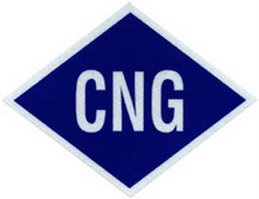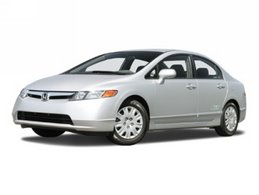Storing CNG in Corncobs
Any news about corn as it relates to alternative fuels is usually reserved for ethanol. It turns out that the abundant cash crop has more to offer in the way of clean-burning energy than simply providing a feedstock for fuel.
Researchers from the University of Missouri-Columbia (MU) and the Midwest Research Institute (MRI) in Kansas City have found a way to use corncobs to store natural gas – and at an all-time high density, no less. With corncob waste as a starting material, the researchers have created carbon briquettes with complex nano-scale pores that can store 180 times their own volume of natural gas at a pressure of 500 psi. Significantly, these corncob-based briquettes are the first technology to meet the 180:1 storage-to-volume ratio that the U.S. Department of Energy set as a development goal in 2000. A pickup truck equipped with the corncob-based natural gas storage is currently in regular use by the Kansas City Office of Environmental Quality.
The breakthrough is great news for natural gas-powered transportation. The ability to store more energy per volume means increased driving range without sacrificing interior volume. Furthermore, the relatively low 500 psi storage pressure is the same as that of natural gas pipelines, eliminating the need for compression to the 3600 psi used in today’s bulky storage cylinders. The low pressure of this new technology opens the door for flexibility in tank design similar to today’s gasoline tanks – a flat, compact shape that could fit under the passenger floor.
http://www.greencar.com/news/storing-cng-in-corncobs
From the HORIZON Solutions Site, www.solutions-site.org
Energy
Record-breaking Methane Storage System Derived From Corncobs May Encourage Mass-market Natural Gas Automobiles
By
Feb 22, 2007, 3:21pm
Researchers at the University of Missouri-Columbia and the Midwest Research Institute in Kansas City have developed a method to convert corncob waste into a carbon "sponge" with nanoscale pores. The new material can store large quantities of natural gas and can be formed into a variety of shapes, ideal characteristics for next-generation gas storage tanks on methane-powered automobiles.
 |
| Researchers have developed a corncob-derived carbon "sponge" that can store natural gas. Photo by Nicolle Rager Fuller, National Science Foundation |
Using corncob waste as a starting material, researchers have created carbon briquettes with complex nanopores capable of storing natural gas at an unprecedented density of 180 times their own volume and at one seventh the pressure of conventional natural gas tanks.
The breakthrough, announced on February 16, 2007 in Kansas City, Mo., is a significant step forward in the nationwide effort to fit more automobiles to run on methane, an abundant fuel that is domestically produced and cleaner burning than gasoline.
Supported by the National Science Foundation (NSF) Partnership for Innovation program, researchers at the University of Missouri-Columbia (MU) and Midwest Research Institute (MRI) in Kansas City developed the technology. The technology has been incorporated into a test bed installed on a pickup truck used regularly by the Kansas City Office of Environmental Quality.
The briquettes are the first technology to meet the 180 to 1 storage to volume target set by the U.S. Department of Energy in 2000, a long-term goal of principal project leader Peter Pfeifer of MU.
"We are very excited about this breakthrough because it may lead to a flat and compact tank that would fit under the floor of a passenger car, similar to current gasoline tanks," said Pfeifer. "Such a technology would make natural gas a widely attractive alternative fuel for everyone."
According to Pfeifer, the absence of such a flatbed tank has been the principal reason why natural gas, which costs significantly less than gasoline and diesel and burns more cleanly, is not yet widely used as a fuel for vehicles.
Standard natural gas storage systems use high-pressure natural gas that has been compressed to a pressure of 3600 pounds per square inch and bulky tanks that can take up the space of an entire car trunk. The carbon briquettes contain networks of pores and channels that can hold methane at a high density without the cost of extreme compression, ultimately storing the fuel at a pressure of only 500 pounds per square inch, the pressure found in natural gas pipelines.
The low pressure of 500 pounds per square inch is central for crafting the tank into any desired shape, so ultimately, fuel storage tanks could be thin-walled, slim, rectangular structures affixed to the underside of the car, not taking up room in the vehicle.
Pfeifer and his colleagues at MU and MRI discovered that that fractal pore spaces (spaces created by repetition of similar patterns at different scales) are remarkably efficient at storing natural gas.
"Our project is the first time a carbon storage material has been made from corncobs, an abundantly available waste product in the Midwest," said Pfeifer. "The carbon briquettes are made from the cobs that remain after the kernels have been harvested. The state of Missouri alone could supply the raw material for more than 10 million cars per year. It would be a unique opportunity to bring corn to the market for alternative fuels--corn kernels for ethanol production, and corncob for natural gas tanks."
The test pickup truck, part of a fleet of more than 200 natural gas vehicles operated by Kansas City, has been in use since mid-October and the researchers are monitoring the technology's performance, from mileage data to measurements of the stability of the briquettes.
In addition to efforts to commercialize the technology, the researchers are now focusing on the next generation briquette, one that will store more natural gas and cost less to produce. Pfeifer believes this next generation of briquette might even hold promise for storing hydrogen.
Natural Gas Vehicle Facts
Provided by the MU-MRI Collaboration
Natural gas is one of the cleanest burning alternative fuels available.
- In light-duty applications, air emissions from natural gas vehicles are lower than emissions from gasoline-powered vehicles. Carbon monoxide and nitrogen oxides, smog-producing gases, are reduced by more than 90 percent and 60 percent, respectively. Carbon dioxide, a greenhouse gas, is reduced by 30 to 40 percent.
- In medium- and heavy-duty applications, natural gas engines have shown a more than 90 percent reduction of carbon monoxide and particulate matter and a more than 50 percent reduction of nitrogen oxides, relative to commercial diesel engines.
Source: U.S. Department of Energy, Energy Efficiency and Renewable Energy, Alternative Fuel Vehicles
Most natural gas used in the U.S. is domestically produced.
- In 2004, U.S. net imports of natural gas represented only 15 percent of the total amount used, with almost all imports coming from Canada.
Source: U.S. Department of Energy, Energy Efficiency and Renewable Energy, Alternative Fuel Vehicles
Natural gas is cheaper than gasoline and diesel on an energy-equivalent basis.
- The national average cost of compressed natural gas (CNG) was 94 cents cheaper than gasoline on an energy-equivalent basis, according the Clean Cities Alternative Fuel Price Report in June 2006. Gasoline was $2.84 per gallon, diesel was $2.98 per gallon, and CNG was $1.90 per gasoline gallon equivalent (GGE).
Source: U.S. Department of Energy, Energy Efficiency and Renewable Energy report,
Natural gas can be produced from renewable sources such as landfills.
- As municipal solid waste decomposes, it produces carbon dioxide and methane. That methane, the principal component of natural gas, can be captured by landfill gas energy facilities and combusted for energy.
Source: Energy Information Administration,
- Uncaptured methane is a greenhouse gas that is more than 20 times more potent than carbon dioxide.
Source: U.S. Environmental Protection Agency, Landfill Methane Outreach Program.
- Capturing methane from all U.S. landfills is equivalent to removing the annual greenhouse-gas emission from 50 million cars, or planting forest on an area 2 times the area of Missouri every year, and could power 4 million homes or 4 million cars annually ("pollutant to renewable energy").
Sources: U.S. Environmental Protection Agency, Landfill Methane Outreach Program, and Additional calculations by Peter Pfeifer, MU professor of physics
Natural-gas fueled vehicles are functionally comparable to conventionally fueled vehicles.
- Horsepower, acceleration and cruise speed in natural-gas-powered vehicles are comparable to equivalent conventionally fueled vehicles.
- Approximately one of every five new U.S. transit buses is powered by natural gas.
Source: U.S. Department of Energy, Energy Efficiency and Renewable Energy, Alternative Fuel Vehicles,
MU-MRI Low-Pressure Tank Facts
Provided by the MU-MRI Collaboration
- The MU-MRI low-pressure natural gas tank uses carbon briquettes made from corncobs to store natural gas. The walls of the nanoporous carbon adsorb methane molecules as a high-density fluid. The strong attractive force in the narrow pores lowers the energy of the molecules so that they can be packed much more closely than in the absence of the carbon. Such a tank is called an adsorbed natural gas (ANG) tank.
- The carbon briquettes can store 180 times their own volume of natural gas, or 118 g of methane per liter of carbon, at 500 pounds per square inch (psi). The best previous carbon could only store 142 times its own volume at 500 psi pressure. The target set by the U.S. Department of Energy is 180 times the storage a material's own volume. The MU-MRI carbon reaches this target for the first time.
- A conventional high-pressure natural gas tank operates at 3600 pounds per square inch (psi), whereas this low-pressure tank operates at 500 psi. This enables flexibility in tank design because high-pressure tanks require bulky, cylindrical walls, whereas the low-pressure tank can use thinner walls in a variety of shapes. The pressure of 500 psi equals the pressure in natural gas pipelines, which eliminates costly compression of natural gas from 500 psi to 3600 psi in CNG tanks.
- The technology being tested in this tank would enable car manufacturers to design long, slim, low-pressure tanks to replace the bulky high-pressure tanks in current natural gas vehicles. This would enable them to place the tank underneath the body of the car, whereas the high-pressure tanks are usually placed in a car's trunk, reducing vehicle cargo space.
- Corncob is an abundant, low-cost, renewable raw material in the Midwest, allowing for production of ANG tanks from domestic sources. The state of Missouri alone could supply the raw material for ANG tanks of 10 million cars per year. Corn could thus serve the alternative fuel economy in two distinct ways--corn kernels for bioethanol production, and corncob for natural-gas tanks.
Source: Calculations by Peter Pfeifer, MU professor of physics, using data from the Corn Refiners Association.
Program Contacts
Sara B. Nerlove, NSF (703) 292-7077 snerlove@nsf.gov
Principal Investigators
Peter Pfeifer, University of Missouri - Columbia (573) 882-2335 pfeiferp@missouri.edu
Media Contacts
Joshua A. Chamot, NSF (703) 292-7730 jchamot@nsf.gov
Linda Cook, Midwest Research Institute (816) 360-1943 lcook@mriresearch.org
Katherine Kostiuk, University of Missouri - Columbia (573) 882-3346 burgk@missouri.edu
The National Science Foundation (NSF) is solely responsible for the contents of this press release of February 16, 2007.
NSF Web Sites:
NSF Home Page: http://www.nsf.gov
NSF News: http://www.nsf.gov/news/
About the research collaboration: The MU-MRI collaborative is part of a larger cooperative effort called the Alliance for Collaborative Research in Alternative Fuel Technology (ALL-CRAFT), which includes as partners Lincoln University; DBHORNE, LLC; Renewable Alternatives, LLC; the Missouri Biotechnology Association; the Clean Vehicle Education Foundation; the Missouri Department of Natural Resources; and the City of Columbia, Mo. ALL-CRAFT also worked in cooperation with the Kansas City Regional Clean Cities Coalition (KCRCCC).
About PFI: This project was funded by a $600,000 grant from the National Science Foundation's program Partnerships for Innovation, which has the goal of stimulating the transformation of knowledge created by universities into innovations that create new wealth, build strong local, regional and national economies and improve the national well-being. Additional funds totaling more than $400,000 came from MU, MRI, the U.S. Department of Energy and the U.S. Department of Education.
A secondary goal of the Partnership for Innovation is to meet the broad workforce needs of the national innovation enterprise. The collaborative effort between MU and MRI has afforded a number of university students the opportunity to receive hands-on training for a career in research and development. As a result of the exchange, MRI recently hired an MU graduate and a Lincoln University graduate associated with the project team.
NOTE:
Links with detailed information are available on the Horizon Solutions Site:
The categories are:
Agriculture, Air Pollution, Biodiversity, Desertification, Energy, the Environment, Global Climate Change, Human Rights, Industry, Population, Poverty, Public Health, Sustainable Development, Transportation, Waste Management, Water, Organizations and Foundations, Research and Information, Web Directories and other Media, and Horizon Solutions Site Collaborators
Copyright 2003 HORIZON International. Yale University Department of Biology. P. O. Box 208103 New Haven, CT 06520-8103 USA. Tel: 203-432-6266, Fax: 203-432-6161. Email: info@solutions-site.org


